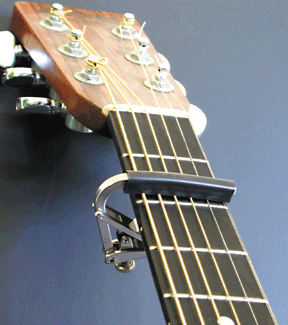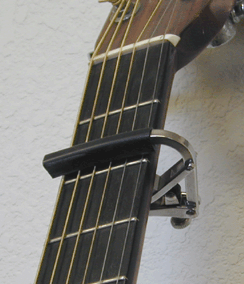Which is the right way to apply a Shubb Capo?


Some players who apply their Shubb from above (bass side) are:
James Burton, Andy McKee, John Jorgenson, Keith Richards, Paul Simon, Joe Bonamassa, Jimmie Vaughan, Eric Johnson, Sheryl Crowe, Brian Setzer, Sting, Gordon Lightfoot, Jerry Jeff Walker, Peter Frampton, Carrie Underwood.
Some players who apply their Shubb from below (treble side) are:
Pete Townshend, Garth Brooks, Bonnie Raitt, the Edge, Doyle Dykes, Eric Clapton, John McEuen, Mark Knopfler, Ry Cooder, John Sebastian, Jorma Kaukonen, Steve Earle, Elvin Bishop, Bruce Springsteen.
Which group are you in? Personally, I have always used it from below, or the treble side, which feels more natural to me because it is like my hand closing onto the neck.From my observation, the two camps run nearly 50-50, even among top players, with perhaps a slight edge going to the bass side, or "from above" users (pictured left). This preference might be because it favors certain first position chords (B7, for instance). Some people might believe that the capo provides more pressure from the side of the bar nearer the hinge, but this is not really the case.
Other aspects of capo placement are far more important than the direction (from above or below), such as:
- the amount of pressure (just enough, not too much)
- the proximity to the fret (just behind, as you would place your finger)
- the direct application onto the strings, not pushing or pulling them to one side.
Shubb Capos are by far the best for not creating tuning problems. Learn more..
More about capoing technique:
The closing action and resilient rubber materials of a Shubb capo make it unusually forgiving; you can apply it without paying too much attention, and it will perform better than other capos applied in the same manner. But for the best accuracy, taking about two seconds longer to place it carefully will produce the best results.
1) Press the rubber-sleeved bar against the strings parallel to the fret, just behind the fret. Make sure it is is pushing from directly above the strings, so it is not pushing them to one side or the other. Make sure that both the 1st and 6th strings are completely covered.
2) While holding it with equal pressure across the width of the fretboard, close the lever. Done.
It is not crucial for the curve of the capo's middle piece (the part that goes against the back of the neck) to exactly match the shape of your guitar neck, nor is it crucial for that piece to contact the neck right in the middle.